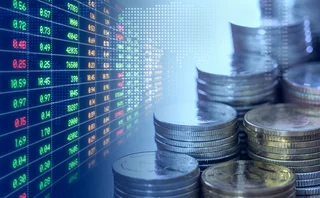
Citi tops second edition of Risk’s Dealer Rankings
Dealer Rankings 2024: Data shows five big US dealers still lead, but with Europeans closing in

The hidden pecking order of the top derivatives dealers for US funds and life insurers has been shaken up, with Citi jumping to the summit in the second edition of Risk.net’s Dealer Rankings, a quantitative analysis of more than 1,000 cuts of trade-level data collected from regulatory filings.
The top five dealers in this year’s rankings are all US names – the same five as last year, but in markedly different order. Bank of America and JP Morgan are hot on Citi’s heels, in second and third, respectively – but BofA jumped three spots to get there, while JP Morgan slid one spot in the table.
Goldman Sachs also dropped a place to fourth, tying with Morgan Stanley, which dropped four places after beating JP Morgan to the top spot last year.
Three European institutions – Barclays, BNP Paribas and Deutsche Bank – gave Wall Street’s champions a run for their money, but it was the UK dealer that came closest to breaking into the top five, after a dramatic improvement in its rates footprint with mutual funds and ETFs.
Wells Fargo and UBS complete the top 10, replacing Credit Suisse and HSBC. Credit Suisse, unsurprisingly, plummeted in many of this year’s tables, and now stands fifteenth overall, while its acquirer jumped three places.
In all, across the 10 different over-the-counter instruments covered by the rankings data, 59 dealers fight for the business of US funds and life insurers, but the vast majority compete only selectively – sometimes not just in specific instruments, but with specific clients. Even some of the big five US banks appear to shun certain products or client groups.
Further snapshots of the results – and brief commentary – can be found below, along with some background on the underlying data and rankings methodology. Over the coming week, Risk.net will publish detailed analysis of the top 10 dealers and each of the 16 combinations of product and client covered.
It’s important to be clear on what the rankings are, and are not, though. They reflect the trading activity of dealers with two US client groups during the 2023 calendar year – size of trades, number of tickets, number of clients – and are based on quarterly snapshots of client positions. They are not a reflection of revenue, and do not capture all transactions executed during the year.
Inside the box
The Dealer Rankings are an offshoot of Counterparty Radar, our OTC derivatives database. The data is collected from quarterly filings made to the US Securities and Exchange Commission by mutual funds and ETFs, and to US state insurance commissioners by life insurers. Each of those filings contains a snapshot of trades on each firm’s book, along with the sell-side counterparty to the trade.
When cleaned and aggregated, these filings shed light on a host of questions that are otherwise difficult or impossible to answer – the identities of all buy- and sell-side participants in a range of OTC products, for example, as well as the hidden relationships between them, and some of their trading behaviour.
In the coming months, similar data from European Ucits funds will be added to the database.
The Dealer Rankings use this data to look at the footprint of each dealer. The underlying data is not perfect, and the rankings methodology involves some trade-offs and assumptions – but it remains unique in the level of transparency and detail it offers.
Feedback from senior traders on the buy side – who were given a preview of the results – also proved that the rankings often tally well with the opinions and experiences of market participants. Not always, though – no participant has a helicopter view of the entire market, or perfect understanding of each firm’s business, and part of the value of the rankings is in challenging some of the assumptions that arise as a result.
The rankings tables are produced by slicing the data for each instrument into sub-segments we called ‘cuts’ – more than 1,000 of them in all. These reflect different underlyings, trade sizes, trade maturities, and regions. Each of these cuts becomes a ranking of its own – dealers are ordered by the notional size of the ‘book’ of trades they executed, the number of tickets, and the number of clients they traded with, as well as year-on-year growth in each of those metrics. Points are awarded to every dealer that is present in one of these cuts, based on how many other dealers they beat.
Taking inflation swaps with mutual funds as an example, JP Morgan executed more tickets than the six other banks that traded US CPI-referencing swaps with this client group in last year’s data, so it receives six points in this cut; but the notional size of its book of long-dated inflation swaps was only greater than one other dealer, so it accumulates a single point here. Dealers accumulate points across 78 inflation swap cuts in total.
These points are then added up to create an instrument-level ranking for each client group. Across the four asset classes covered in the data – credit, equity, FX and rates – mutual funds trade nine of the 11 OTC derivatives instruments covered by Counterparty Radar and insurers trade seven.
Based on their standing in these instrument-level rankings, dealers are awarded a fresh set of points, which are aggregated to create an overall ranking for mutual funds and another for insurers – across the various instruments. And at the very end, the tables for the two client groups are combined to create the overall ranking.
Note that the rankings only include data from the US buy-side firms covered by Counterparty Radar. We plan to publish a similar analysis based on data from European funds later this year.
Trading places
Morgan Stanley finished first in last year’s overall Dealer Rankings, a single point ahead of JP Morgan. The same thing happened this year – the difference between first and second in the overall rankings table came down to one point. This time, however, it was Citi a whisker ahead of Bank of America.
Citi’s strength was in the six rates and credit instruments, where it had a better average rank than any other dealer. With mutual funds and ETFs, it came top for interest rate swaps and single-name CDSs, and its lowest rank in any rates. With insurers, it added a first in inflation swaps. Its lowest placing in any rates or credit product was a fifth for swaptions with insurers.
BofA finished joint first overall for mutual funds and ETFs, after collecting three firsts with that client group – for index CDSs, FX options, and repo. It finished second overall for insurers, with no first place, but strong results across all instruments bar FX forwards.
JP Morgan improved its standing with mutual funds and ETFs, with a first place in credit options and seconds in FX options, inflation swaps, swaptions and single-name CDSs. It was less strong with insurers, collecting one second, but appearing in the top 10 for every instrument. Its ranking in four insurer instruments was lower than last year.
Goldman had a strong year in equity options, where it took the top spot with insurers, jumping five places in the table. Insurers also gave the bank a first for single-name CDSs. Overall, the bank finished third with insurers – up a spot from last year – but it lost ground in most of the mutual fund instruments and slipped to fifth with this client group.
JP Morgan and Morgan Stanley were the only dealers to rank in the top 10 of all individual instruments, but the latter slipped significantly in some instruments, including losing seven spots in swaptions with mutual funds and ETFs.
Barclays closed last year’s gap between fifth and sixth, finishing narrowly behind Morgan Stanley – and within touching distance of Goldman. A big factor in its improvement were jumps of five, four and seven spots in interest rate swaps, inflation swaps, and swaptions with mutual funds. It appeared in the top 10 for all instruments with this client group, picking up enough points to finish second overall – up from fifth last year – but only finished seventh with insurers.
BNP Paribas was the second-strongest European dealer, reaching the summit in two of the most competitive instruments: FX forwards with mutual funds, and interest rate swaps with insurers. In the latter, the French bank surged seven places up the table – the biggest such jump, along with Barclays’ jump in swaptions with mutual funds.
Deutsche Bank fell further behind its European rivals in this year’s rankings, but continued to be a formidable competitor in rates, particularly with insurers where it grabbed a first in swaptions, a second in inflation swaps, and fourth in rate swaps.
Deutsche also marks the point in the rankings below which banks are less consistently visible across the various instruments. Of the two new entrants in the top 10, Wells Fargo was best with insurers, who gave it second place in interest rate swaps and swaptions. It appeared in a further four top 10s. UBS had a third-place finish with mutual funds in FX forwards, and also appeared in the top 10 for four other instruments.
Outside of the top 10 dealers, there were notable successes for Societe Generale, which grabbed second for FX forwards and sixth for equity index options – both with insurers. HSBC took fifth for FX forwards with mutual funds and appeared in the top 10 for four other instruments across the client groups. Royal Bank of Canada landed in fifth for FX forwards with insurers, and fifth in repo with mutual funds. Nomura took five top 10 places altogether.
Editing by Duncan Wood
Only users who have a paid subscription or are part of a corporate subscription are able to print or copy content.
To access these options, along with all other subscription benefits, please contact info@risk.net or view our subscription options here: http://subscriptions.risk.net/subscribe
You are currently unable to print this content. Please contact info@risk.net to find out more.
You are currently unable to copy this content. Please contact info@risk.net to find out more.
Copyright Infopro Digital Limited. All rights reserved.
As outlined in our terms and conditions, https://www.infopro-digital.com/terms-and-conditions/subscriptions/ (point 2.4), printing is limited to a single copy.
If you would like to purchase additional rights please email info@risk.net
Copyright Infopro Digital Limited. All rights reserved.
You may share this content using our article tools. As outlined in our terms and conditions, https://www.infopro-digital.com/terms-and-conditions/subscriptions/ (clause 2.4), an Authorised User may only make one copy of the materials for their own personal use. You must also comply with the restrictions in clause 2.5.
If you would like to purchase additional rights please email info@risk.net
More on Markets
FXGO volumes surge despite fee switch-on
Dealers split on whether levy is behind volume increases across SDPs
Banks hope new axe platform will cut bond trading costs
Dealer-backed TP Icap venture aims to disrupt dominant trio of Bloomberg, MarketAxess and Tradeweb
Kyriba sees uptake in AI-assisted FX hedging tools
Automated data collection and cleaning helps corporates create better hedges and has cut unexplained P&L moves by 87%, says vendor
Review of 2025: It’s the end of the world, and it feels fine
Markets proved resilient as Trump redefined US policies – but questions are piling up about 2026 and beyond
Does crypto really need T+0 for everything?
Instant settlement brings its own risks but doesn’t need to be the default, writes BridgePort’s Soriano
Asset managers prep autocall ETFs with assets tipped to hit $30bn
Actively managed strategies wait in the wings after systematic approach nets Calamos $500m
Citi launches core inflation QIS
Custom indexes eliminate energy and food prices to ease trading of stickier inflation trends
US insurers turn to short-dated FX forwards as notionals rise
Counterparty Radar: Trades under three months make up nearly 60% of total positions, up from just a third in 2022








